If there’s any animal that visitors want to see in Costa Rica, it’s the sloth. The sloths in Costa Rica have become the symbol of the country due to its oh-so-adorable face, snuggly body and very pura vida lifestyle.
If it’s your life goal to see one of these precious perezosos during your trip to Costa Rica, it’s best to do a bit of research about them first. Sloths are common in Costa Rica but not so common that you’ll see them everywhere all the time. Since they camouflage themselves so well, you could walk past a handful of them and never notice!
So here I answer the question that many of you ask: where to see sloths in Costa Rica?
This post has affiliate links which we may earn a small commission from if you choose to purchase, at no extra cost to you. Any prices listed may not reflect current pricing. It is the readers responsibility to research current pricing. Prices are quoted in USD. More info: Disclosure
Types of Sloth Species in Costa Rica: Hoffman’s two toed sloth and Brown throated sloth
There are two species of sloths in Costa Rica: the Brown throated sloths, a species of three toed sloth and the Hoffmann’s two toed sloth.
Did you know that the technically correct name for these sloths are 3-fingered and 2-fingered? This is because BOTH sloths have 3 toes on their hind feet but their fingers are different!
Two fingered sloth
This two-fingered sloth is largely nocturnal, so it’s harder to see them than the 3-fingered sloth. If you do see them, they will most likely be sound asleep.
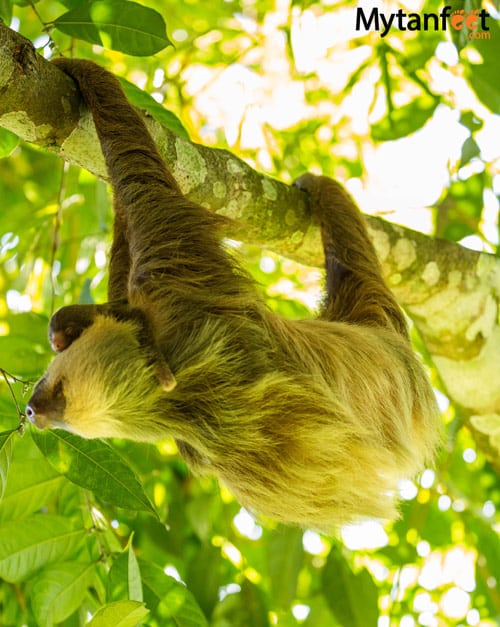
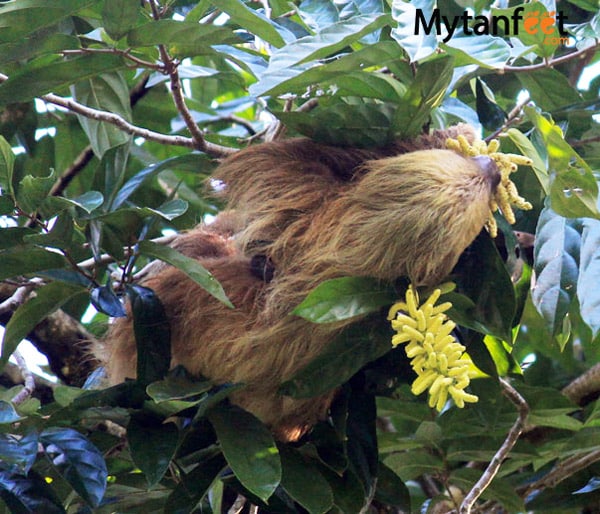
Their two front feet have two toes, each with a set of long curved claws. However, their hind feet have three toes.
They differ from the 3-fingered sloth by their longer snout, separate front toes, larger size and no hair on the soles of the feet.
Three-fingered Sloths
The Brown-throated sloth is the most common of the 3-fingered sloth species. All of their feet have 3 fingers with long claws. They have a round head and a short nose.
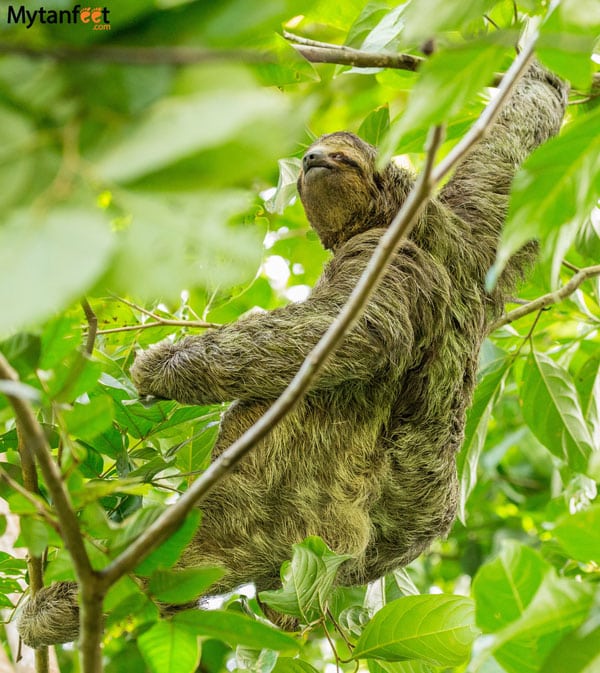
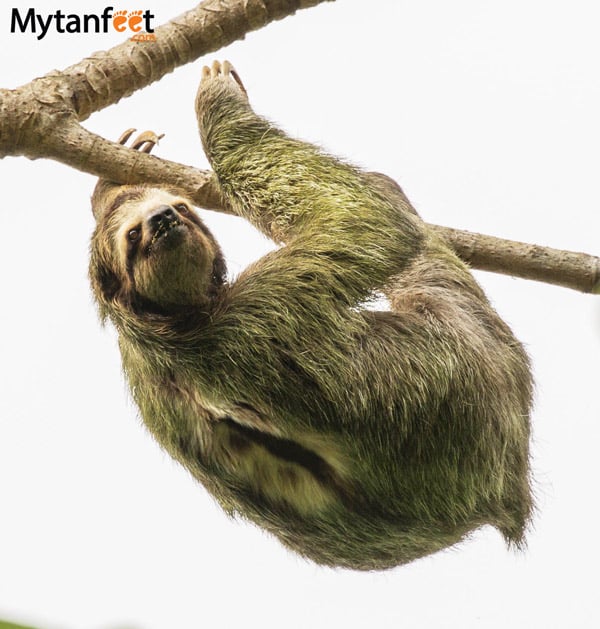
They sleep around 15 hours and are active both day and night.
Where to See Sloths in Costa Rica
The best places to see sloths in Costa Rica are Manuel Antonio, Osa Peninsula, La Fortuna, Caño Negro (Northern Plains), Tortuguero, Puerto Viejo, Cahuita, Dominical, Uvita, Ojochal, Monteverde and Bijagua.
These are all year round tropical rainforest areas so both sloths are found in these areas and always have food. This is the reason why it is nearly impossible to see sloths in Guanacaste because of its dry tropical forest.
I’ll talk about Guanacaste more in a bit and how to see sloths if you are staying in places like Playas del Coco, La Cruz, Tamarindo, Papagayo Peninsula, Samara, Nosara, Santa Teresa and Montezuma.
Three fingered and two fingered sloths are found in the same places throughout the country. However, only two fingered sloths live in high elevation areas (above 1000 meters or so, 3000 feet in elevation).
They have more hair and can survive in colder temperatures whereas the three fingered sloth cannot. You will find only two fingered sloths in places like Monteverde, Poas and Vara Blanca.
Costa Rica Sloth Sanctuaries and Wildlife Rescue Centers
If you absolutely have to see a sloth, then the best option is to visit a wildlife refuge or sanctuary.
Please note that you cannot pet, touch or hold sloths in Costa Rica. No “sanctuary” or sloth tour should allow you to do this as it is extremely bad for the sloth’s health.
They get very stressed out and humans can transmit bacteria and other harmful things to the animal.
In these centers, you will see mostly see only two toed sloths since they are easier to rehabilitate and keep in captivity due to their diet.
Two toed sloths have a more variable diet (leaves, fruits, insects) whereas three toed sloths eat strictly leaves and are harder to keep in captivity.
Rescue Centers
These wildlife rescue centers work to rehabilitate and release injured and abandoned sloths back into their natural habitat.
Visiting reputable wildlife refuges is a great way to give back to the community and help the animals. Many wildlife refuges also offer volunteer programs.
Jaguar Rescue Center: This rescue center helps and rehabilitates all sorts of animals, including sloths. Located in the Caribbean, part of the La Ceiba wildlife refuge by Puerto Viejo de Talamanca.
Proyecto Asis: A wildlife rescue center a little outside of La Fortuna. Offers guided tours and volunteer opportunities and a dedicated sloth sanctuary tour.
Toucan Rescue Ranch: This rescue ranch is in Heredia and rescues and rehabilitates wildlife. However, many of their animals are permanent residents as they were too injured to be released or were unable to survive in the wild on their own. If you are staying in San Jose and have a couple days in the city, you can visit their wildlife sanctuary and rescue center.
Alturas Wildlife Sanctuary: This rescue center in Dominical rescues, heals and rehabilitates as much wildlife as they can back into the wild. They take care of any and all animals that are injured. You can take a guided tour to learn more.
Sanctuaries
These sloths are already rehabilitated permanent residents as they are unable to survive in the wild (kept as pets, handicapped, disabled, born in captivity, etc.)
Springs Resort & Spa: This hotel in La Fortuna has a small animal sanctuary with two toed sloths.
La Paz Waterfall Gardens: They have a couple two toed sloths in the waterfall park in Vara Blanca. (Get 7% off the gardens entrance fee in the link)
Diamante Adventure Park: This adventure park by the RIU Guanacaste (Gulf of Papagayo) has a animal sanctuary with two toed sloths. (Get 10% off the park entrance in the link)
Selvatura Park: Selvatura Park’s sloth sanctuary allows guided tours to learn more about the sloths.
Some of the rescue centers have permanent sloths in their care.
**Not a rescue center or refugee** The Sloth Institute: Non profit dedicated to conservation and education on sloths. Their main goal is to release sloths back in the wild. Though they aren’t open to the public, if you want to learn more about sloths, they are the place to ask. They do a sloth walk on the Tulemar property in Manuel Antonio every day which is only open to Tulemar guests (we saw 10 sloths when we were there!)
How to Guarantee Sloth Sightings
The best way to see a sloth in the wild is to hire a naturalist guide. They are trained for spotting sloths as they are masters at camouflage and are usually very high up in the trees. Guides will have binoculars and telescopes to find them.
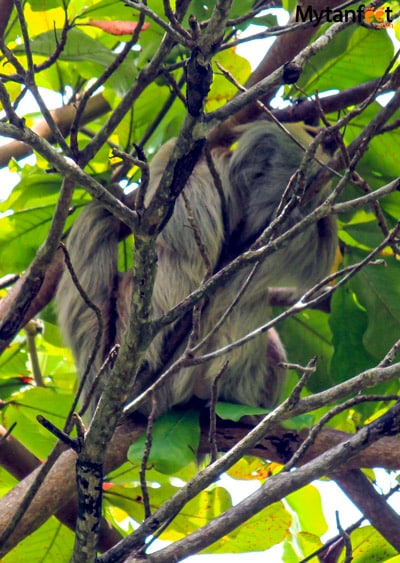
The first time I ever saw a sloth in their natural habitat was in Manuel Antonio National Park, thanks to a guide. Sloth spottings were all thanks to the guide and their sharp eyes!
If you are on your own and want to try to find a sloth by yourself, look for this kind of tree with these leaves, called the Guarumo or Cecropia trees.
This is the sloths’ FAVORITE tree and you will commonly see them sleeping and eating in this tree.
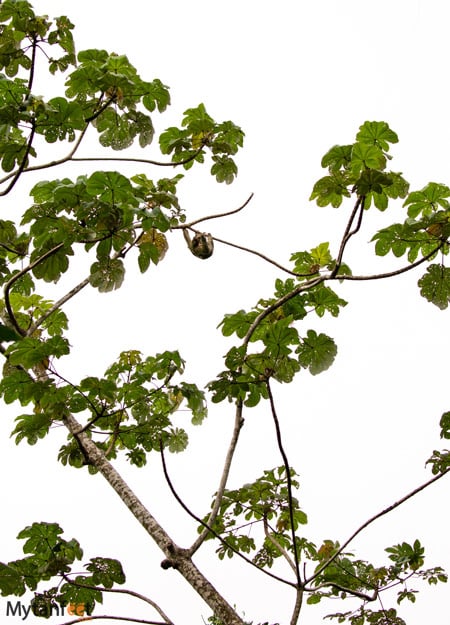
As sloths do not live on the forest floor, don’t look on the ground. Always look up in the trees. The only time sloths are on the forest floor is when they use the bathroom once a week.
Sloths in Guanacaste
It’s impossible to see sloths in Guanacaste on the Pacific coast as it is too dry for them being the dry tropical forest.
There are no sloths on the beaches of the North Pacific Coast, you will need to go inland to the lush rainforests to see sloths in the wild.
So if you are staying at the Westin Conchal, Riu Palace, Riu Guanacaste, Tamarindo Diria, Secrets Papagayo, Planet Hollywood, Andaz Papagayo or any of these resorts, you will not see sloths in the trees on the beach.
La Fortuna and Bijagua are your best options to see sloths in the wild from Guanacaste. They are 3.5 hours and 1.5-2.5 hours from the Coco/Tamarindo areas.
One of our partners runs a fantastic full day excursion to a rainforest hanging bridges reserve and sloth reserve in Bijagua to see the rainforest and sloths. Check the link to see what the tour is like and to request to book it!
If a full day excursion is a bit too much for you, then your next best option is the Diamante Eco Adventure Park which is just 30 minutes from Guanacaste Airport. Visit their animal sanctuary to see their sloths and watch the sloth feedings.
Sloths in La Fortuna
There are a lot of sloths in the La Fortuna and Arenal area but not in the Arenal Volcano National Park. You will need to look in the primary and secondary rainforests in the area.
It may seem like there aren’t any sloths there but you just need to know where to look. There are a couple of “sloth walks” right in downtown Fortuna.
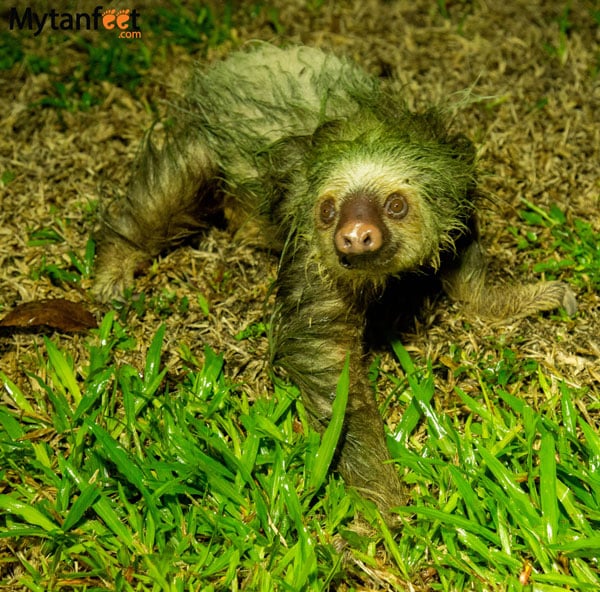
A lot of hotels have sloths on their property. We saw sloths during our stay at Nayara Hotel, The Springs Resort, El Secreto and at our Airbnb right outside town.
Sloths in Monteverde
Only the 2-fingered sloth lives in Monteverde due to the cold climate. Since these sloths are mostly nocturnal, it is harder to see sloths in Monteverde.
You may be able to see one on a Monteverde night walk at Finca Santamaria or Kinkajour. I saw an active one during Finca Santamaria’s night walk.
Sloths in Manuel Antonio
At Manuel Antonio National Park, there are a lot of sloths that live in those rainforests. As this national park is fairly small, you have a good chance to see a sloth on your own at the national park or on your hotel’s property.
Get a discount off your Manuel Antonio tour including the national park guided walk here.
Hotels
Many hotels in Costa Rica have wild sloths on the property.
We have seen sloths at the Nayara Hotel in La Fortuna, The Springs Resort in La Fortuna, Hotel Cuna del Angel in Dominical, Hotel Banana Azul in Puerto Viejo, Villas del Caribe in Puerto Viejo, Evergreen and Aninga Lodge in Tortuguero, Mawamba Lodge in Tortuguero and Tulemar in Manuel Antonio.
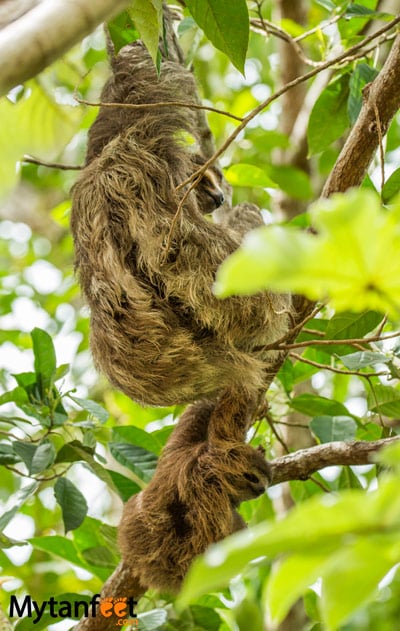
So if you really want to see a sloth in the wild, you can also book a hotel that has sloths on their property! Read reviews to see what people say.
This is how I found the Airbnb in La Fortuna because all the past guests said they saw lots of sloths right on the property.
Tips for Seeing Sloths in Costa Rica
- Do not touch them. If you see one, don’t touch it. A certain species of moth lives and lays their eggs in the fur of the three-toed sloth. A type of red algae also lives in their fur giving them an illusion of moss. Sloths also get stressed out when touched by humans.
- Always look up in the tree tops and through the trees. I’ve walked under a sloth that was literally 5 feet above my head but didn’t notice until someone told me to look up.
- Bring a pair of good binoculars or a long zoom lens for an up close look/photos. If you’re with a guide, many of them bring telescopes. You can use your cell phone camera to take a picture of it through the telescope
- If you see an injured sloth and you have a phone, you can call 911 and ask for the nearest wildlife rescue center. If there is a local nearby, ask them for the closest vet or ask if they can help (some locals may have had previous experiences with sloths especially if they are farmers or naturalist guides).
- Take tons of photos when you see one because they are just so darn cute!
- And please, do NOT hug sloths (and no “sanctuary” should ever allow you to). As awesome as it sounds, you should never touch a wild sloth or any wild animal. Please do not try to move it so you can get a selfie.
What Not to Do When You See a Sloth (Be a Responsible Tourist)
Do NOT hug sloths or hold them. As awesome as it sounds, you should never touch a wild sloth or any wild animal. Likewise, do not try to move it so you can get a selfie.
There is a place in Bijagua that has been accused of keeping sloths in captivity and then releasing them in low hanging trees so tourists can take up close selfies with them, and sometimes even let them hold the sloths. This is not legal. If you unknowingly visit this place, please do not participate in these activities, report them to Senasa and put in a complaint to the Costa Rican tourism board.
Do not touch them. If you see one, don’t touch it. A certain species of moth lives and lays their eggs in the fur of the three-toed sloth. A type of red algae also lives in their fur giving them an illusion of moss. Sloths also get stressed out when touched by humans.
Fun Facts About Costa Rica Sloths
- Mammals that belong to two families: Megalonychidae (two-fingered sloth) and Bradypodidae (three-fingered sloth). There are 6 species within these two families.
- They are related to anteaters, which have a similar set of claws.
- Arboreal mammals, (tree-dwelling) in Central and South America.
- Leaves are their main food source but provide little energy, so they lower metabolic rates and body temperature to balance it out. Hence the sloooow movements.
- They cannot survive outside the tropical rain forests of C. and S. America.
- They defecate and urinate once a week when they climb to the ground.
- Life span of around 20-30 years.
- They are competent swimmers.
Now you know where to see sloths in Costa Rica and it’ll be an amazing moment I promise. Happy sloth watching!
More Costa Rica wildlife posts here!
Guide to seeing Costa Rica wildlife
The creepy crawleys of Costa Rica
Costa Rica Vacation Checklist
- First time to Costa Rica? Read our First Time in Costa Rica guide.
- Not sure how to move around Costa Rica? Read our How to Get Around Costa Rica guide to find the best transportation method for you.
- Click the link to get our detailed Costa Rica Packing List so you know what essential items to bring.
- Do not forget to purchase Travel Insurance for your trip to Costa Rica.
- Stay connected by purchasing a prepaid SIM Card in Costa Rica.
- Save money with Mytanfeet Deals for tours and hotels. Save more money with our Costa Rica Car Rental Discount.

Emily says
Hello,
Do you have any recommendations for volunteering places in Costa Rica?
As a side note, I asked a question on here several weeks ago and assumed I would get an email when someone replied but I haven’t seen anything and I forgot where along your website I commented! Is there any way someone can direct me to where I commented? (I will recall where I made this comment!)
Thanks!
Sammi says
Many places like animal sanctuaries or dog rescue centers will ask for volunteers, some require you to apply, some don’t but you can check their websites or social media.
I saw and answered your comment on the Costa Rica packing list post.
Jorge Berbena says
Remember to respect the natural habitats of sloths and other wildlife during your search. While it’s a wonderful experience to observe these fascinating creatures, it’s crucial to maintain a safe distance and avoid disturbing their natural behavior. Enjoy the adventure and keep your eyes peeled for those incredible perezosos!
Gregg Bernhardt says
Totally awesome pointers and information. During our last visit to Costa Rica, we saw quite a few sloths in Manuel Antonio. Even though we’re not big fans of “commercialized” nature parks (and we do find Manuel Antonio to be a bit too accessible for our liking), we went very early (highly recommend) before the crowds got there and saw about 6 to 8. We even saw a baby, which was amazing. To our delight, quite a few were active, awake and eating 🙂 They really are beautiful to see in the wild; they truly exude pura vida 😀 And, Alturas is an amazing sanctuary. No sloths when we visited, but they’re doing great work there. We got to hear about Lechuga (the olive ridley sea turtle they were rehabilitating). No water up there in the mountain, so they go down and get fresh sea water in the truck every day and schlepp it all the way up the mountain to change her pool!
Carl Reese says
Random question, I saw a sloth in Cahuita a few years ago and a local told me a name for sloth in Spanish. I can’t recall the name but it wasn’t perezoso, which is what the dictionary says. Is there a slang term for sloth in Costa Rica that starts with a C?
Sammi says
Hi, sorry not that we know of but maybe coati even though that’s a different animal.
Jose Andres Rojas B says
Hi there..!
There is a new option in Arenal where people can take a tour with a trained naturalist guide to find sloths in the wild. This is a company call Callidryas tours who has done a little reserach about the sloth population in the area and can take you to the places where you get a guarranty you see them in the wild, it has also a very professional staff with a really good optic equipment to enjoy the best views of this beautiful animals. I know there are places in Costa Rica where people can find them sometimes without a tour. But this tour is an option if you wanna make sure and don`t miss them while visit Costa Rica.
Sammi says
You’re welcome! I don’t want to tell people that they can’t go somewhere but just from our personal experiences, we don’t include it on our blog but there are a lot of articles and stories on the web that you can read and decide for yourself. A lot of people still go there, we just personally don’t. Thanks for reading our blog!
Sammi says
Hi Paola, I don’t mention it because their way of conducting business is not something that is a good fit for our blog. You can google it to read more stories and get more information, Yeison used to go there with student groups and witnessed it himself. We recommend people to go to the Jaguar Rescue Center instead.
Paola says
Ah, OK, got you. I haven’t come accross any of the negative reviews but I will google it and see. Thank you for your reply and all the info you share with us!
Paola says
Great blog, leaving for CR in two days and love all the info you provide. I haven’t been able to find any info at all about the sloth sanctuary in your blog (the one near Cahuita), is there a reason why it’s not mentioned?
Thank you!
Pierre says
Hi Samantha and Yeison,
Always nice to read your article, gives good pointers in what direction to start!
A little question: Will be around Manuel Antonio and looking to hire a guide, would you have any suggestions of a good person to guide us?
Also thinking visiting Los Quetzales National Park, and maybe getting a guide as well, if you had any suggestions for that area as well?
Thank you very for taking time to share your experiences
Pierre and Isabelle
Sammi says
Hi Pierre, you can find guides in front of the national park entrance and they will come up to you and ask if you want a guide. We have never hired a guide to Manuel Antonio but make sure the guide is ICT certified. You can also book a guide with tour companies in the area like Iguana Tours if you feel more comfortable going with a company.
As for Los Quetzales, it’s not a super popular park so I would see if you can book a tour with your hotel if you’re staying in the area.
Laura says
I’ve also seen them in the Universidad de Costa Rica, in San José. They are soo beautiful.
Sammi says
Wow that’s so cool!
Zara says
Don’t forget about the Toucan Rescue Ranch!
Sammi says
Good one thanks! 🙂
Stacey says
Omg too cute! I love sloths but I’ve never seen them. Awesome guide 🙂
Sammi says
Thanks Stacey! They are so cute, I hope you see one in the wild one day 🙂
Markus says
These guys really are great to see in the wild – one of our favourite spots was El Ceibo in the province of Limon. This is a very popular restaurant stop for tours travelling between San Jose and Tortuguero which has the added bonus of being home to a great population of Blue Jean Dart Frogs!
Sammi says
They sure are! I’ve heard that they are pretty common in Limon as well, I unfortunately didn’t see any when I was there, just means I have to go back. Thanks for the tip about El Ceibo, will make a point to stop there!
Robin says
Very nice article and the places where we can see him as per your article are very helpful, because if anybody wants to see sloths in Costa Rica we can find easily by the list of places they have been spotted.
Thank you for this information.
Sammi says
Thanks Robin, glad it was helpful!